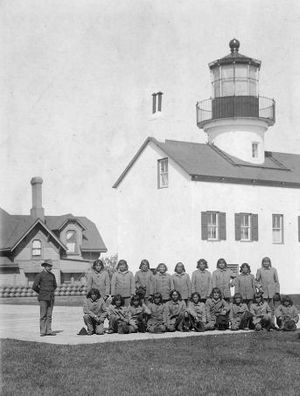Fort Alcatraz facts for kids
Quick facts for kids Alcatraz Citadel |
|
|---|---|
| San Francisco Bay, California, US | |

Model of Alcatraz, 1866–1868
|
|
| Coordinates | 37°49′36″N 122°25′24″W / 37.82667°N 122.423333°W |
| Type | Military defense; military prison |
| Site information | |
| Owner | United States Army |
| Controlled by | Golden Gate National Recreation Area |
| Open to the public |
Yes |
| Site history | |
| Built | 1859 |
| Materials | Masonry, earthworks |
| Garrison information | |
| Past commanders |
James B. McPherson, Joseph Stewart, William A. Winder |
Fort Alcatraz was a special military base on Alcatraz Island in San Francisco Bay, California. It was built by the United States Army to protect the coast. The fort was finished in 1859.
During the American Civil War (1861-1865), it was used to train new soldiers. It also became a military prison starting in 1868. Over time, Alcatraz became more known as a jail than a defense fort. A large concrete prison building was built there between 1910 and 1912. This building was updated in 1933–1934 and became the famous Alcatraz Federal Penitentiary.
Contents
History of Alcatraz Island
Early Days on Alcatraz
The first known people to visit Alcatraz Island were Ohlone Native Americans. They would collect bird eggs and other things from the island. However, they did not usually live there all the time.
Alcatraz in the 1800s
The first recorded owner of Alcatraz was William Workman. He received the island from Mexican governor Pío Pico in 1846. The idea was that Workman would build a lighthouse there. Later that year, John C. Frémont, a U.S. military leader, bought the island. He bought it for the U.S. government.
In 1850, President Millard Fillmore ordered Alcatraz Island to be used only for military purposes. This happened after the U.S. gained California from Mexico. The Mexican–American War had just ended.
After California became part of the United States, the U.S. Army started planning defenses. They wanted to protect the entrance to San Francisco Bay. In 1853, the United States Army Corps of Engineers began building up the island. This work continued until 1859.
The main building built was a "citadel." This was a lightly fortified barracks (a building for soldiers). It was placed on top of the island's rocky hills. Walls of stone and bricks were built around the upper part of the island. A lighthouse was also built, and 11 cannons were put in place.
James B. McPherson, who later became a famous general, served on Alcatraz in 1858. In 1859, Captain Joseph Stewart became the fort's commander.
Alcatraz During the Civil War
Alcatraz began holding soldiers who had committed crimes as early as 1859. By 1861, it was the main military prison for the Pacific region. It held prisoners of war (POWs) from the American Civil War. Starting in 1863, the military also held regular citizens accused of treason.
The number of cells grew in 1867. By 1868, it was a long-term military prison. Alcatraz was very important during the Civil War (1861–1865). It had about 111 cannons around the island at its busiest time. It also served as a war camp.
During the Civil War, federal forces in California had a tough job. They had to stop fights between Union and Confederate supporters. Both groups lived in California. They also had to protect San Francisco. For example, in 1863, a man named Asbury Harpending tried to use a ship to attack U.S. mail ships. These ships often carried valuable metals. The U.S. Navy stopped his plan early.
Because of such events, more people were arrested for treason. To hold these extra prisoners, a temporary wooden prison was built in 1863. In 1864, large 15-inch cannons were added to the fort. More bombproof barracks (buildings safe from bombs) were also built. By the end of the Civil War in 1865, there were over one hundred cannons on the island.
After the Civil War
After the Civil War, the military prison held Confederate supporters. It also held Native Americans during the American Indian Wars. These were Native Americans who resisted the government. On June 5, 1873, Paiute Tom was the first Native American prisoner sent there.
In the 1870s, Major George Mendell ordered prisoners to help change the island's shape. They used mules to move dirt and rocks. They dumped debris into the coves and bay. This created a flatter top level on the island.
In 1882, the citadel was made larger. This was to provide more homes for military officers' families. Between 1873 and 1895, 32 Native Americans were held at Alcatraz. This included 19 Hopi men in 1895.
The island continued to grow in the 1880s. In 1898, the number of people on Alcatraz jumped from 26 to over 450. This was because of the Spanish–American War. More buildings were needed. The original barracks became Building 64 in 1905. The first hospital on Alcatraz opened in 1893.
As more prisoners came, more space was built. Wooden prison buildings were added. But these wooden buildings often caught fire. So, concrete buildings were built to replace them.
Alcatraz in the 1900s
During the Spanish–American War, the number of prisoners grew a lot. By 1902, there were 461 inmates. In 1904, a new prison building was built higher up on the island. It could hold 307 prisoners.
In 1907, Alcatraz was renamed the "Pacific Branch, U.S. Military Prison." As the island's role in defense became less important, prison guards replaced infantry soldiers.
The 1906 San Francisco earthquake barely affected Alcatraz. The city was badly damaged, so many prisoners were moved to the island temporarily. In 1907, Alcatraz stopped being a military defense fort. It became only a military prison.
The original 1860s citadel building collapsed in 1908. It was torn down in 1909, leaving only its basement. A new prison was built on top of this basement by military prisoners. This happened between 1909 and 1911. It was called "the Pacific Branch, U.S. Disciplinary Barracks for the U.S. Army." It became known as "The Rock."
The prison was completely rebuilt with concrete between 1910 and 1912. This was done under Colonel Reuben Turner. Many old tunnels and rooms from the original fort are still there today. This concrete building was updated in 1934. It then reopened as a federal prison. This was the famous Alcatraz prison that held America's most serious criminals until 1963.
In 1915, Alcatraz was renamed the "Pacific Branch, U.S. Disciplinary Barracks." This new name showed that the goal was to help prisoners improve, not just punish them. Soldiers with small offenses could be retrained and sent back to the army. Many reformed prisoners did return to active service.
Even though it was a military prison, there were many escape attempts. Records show 29 escapes involving 80 prisoners. Of these, 62 were caught. The others were never found. In one escape on November 28, 1918, four prisoners escaped on rafts. They were seen in Sutro Forest. Only one was caught, and the others got away.
Transfer to the Justice Department
The Army decided to transfer Alcatraz to the Federal Bureau of Prisons. The Bureau wanted a high-security prison. This was to stop escapes during the time of Prohibition and the Great Depression.
The prison was modernized starting in October 1933. The Alcatraz Federal Penitentiary opened in August 1934. This ended about 80 years of the U.S. Army using the island. Thirty-two hardened Army prisoners stayed at Alcatraz. The rest were moved to other prisons.
Alcatraz Buildings and Features
The main way to get to the island was by ship, like the General McPherson. Once at the dock, you would go up a sloping path behind the sally port (a secure entrance). This path led to the top of the island. Then, you would cross a drawbridge over a 12-foot deep dry moat. The citadel could hold up to 200 men during an emergency. It also had enough supplies to last four months.
The Alcatraz Citadel had a basement with a kitchen, bakery, bedrooms, storage rooms, and jail cells. Above ground, there were two levels. These held living quarters for military staff, servant quarters, living rooms, and a dining hall. Water tanks were built into the ground and on the roof of the citadel.
Other buildings included Batteries Rosecranz and Halleck in the north. There was also a barracks building in the northeast. Battery McClellan and the Fog Bell House were in the south. Battery McPherson was in the west. Batteries Stevens and Mansfield were in the northwest. The lighthouse was next to the main citadel.
Battery McClellan had a large 15-inch Rodman gun. This cannon weighed over 25 tons. It could launch a 330-pound explosive shell 4,680 yards (about 2.6 miles) when aimed at 25 degrees. The Parade Grounds were in the center-left of the island. When the new concrete prison was built in 1910–1912, some parts of the old citadel were reused. Iron staircases from the old building were kept inside. Huge granite blocks, once used to hold cannons, became part of the wharf's walls.
Images for kids






